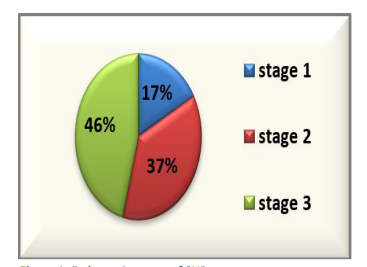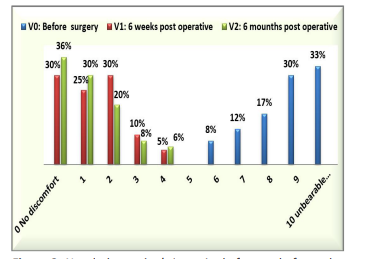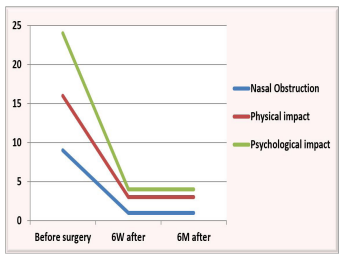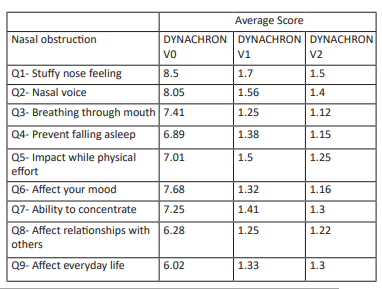Research Article - Volume 3 - Issue 5
Assessment of nasal obstruction before and after surgery of nasal polyposis by the DYNACHRON questionnaire
Douimi L* ; Oukessou Y ; Rouadi S ; Abada R ; Roubal M ; Mahtar M
ENT and Head & Neck Surgery Department, IBN ROCHD University Hospital, Faculty of Medicine and Pharmacy, Hassan II University, Casablanca, Morocco.
Received Date : August 21, 2023
Accepted Date : Sep 20, 2023
Published Date: Sep 27, 2023
Copyright: © Douimi L 2023
*Corresponding Author : :Douimi L, ENT and Head & Neck Surgery Department, IBN ROCHD University Hospital, Faculty of Medicine and Pharmacy, Hassan II University, Casablanca, Morocco.
Email: loubnadouimi@gmail.com
DOI: Doi.org/10.55920/2771-019X/1556
Abstract
Nasal sinus polyposis (NSP) is a chronic inflammatory pathology of the mucosa of ethmoid with an organic and psychosocial impact that may alter the quality of life of patients. It poses a major problem of care.
Objective: The aim of our study is to evaluate the intensity of nasal obstruction, as well as its physical and psychosocial impact, before and after surgery using the DYNACHRON questionnaire.
Material and method: Prospective study carried out within the ENT department of the 20 August 1953 hospital in Casablanca, over a period of 2 years (January 2015-December 2017) including 60 patients. Patients filled the DYNACHRON questionnaire the day before the procedure (V0), 6 weeks (V1) and 6 months after surgery (V2). The issue nasal obstruction includes in addition to the assessment of discomfort, nine items assessing the physical and psychosocial impact. The answer to each item is on an 11 point visual analog scale, graduated from 0 (no annoyance) to 10 (unbearable annoyance)
Result: The average age of our patients was 35, 63% of whom were male. A statistically significant improvement was observed in postoperative DYNACHRON scores concerning both the intensity of nasal obstruction and its physical and mental impact (p <0.001).
Conclusion: The DYNACHRON questionnaire assesses the severity of symptoms and their impact on the quality of life before and after PNS surgery. It is a valid and reliable tool proposed to improve the management of any patient with PNS.
Key words: Nasal polyposis; nasal obstruction; DYNACHRON questionnaire.
Introduction
Sino nasal polyposis (SNP) is a chronic rhinosinusitis with bilateral and multifocal polyps in the nasosinusal cavities especially in the ethmoid [1]. It represents a prevalence estimated to be around 4% in general population. However, its pathophysiology remains poorly elucidated. Indeed, the hypertrophic transformation of the nasosinusal mucosa leads to nasal obstruction, anosmia and sometimes rhinorrhea. In fact, nasal obstruction is one of the main diagnostic criteria for chronic rhinosinusitis according to the definition of EPOS (European Position Paper on Rhinosinusitis and Nasal Polyps) in 2012 [2]; though it has a significant physical and psychosocial impact on quality of life. Several recent studies have shown that nasal obstruction; one of the main symptoms of SNP; has been significantly improved after endoscopic surgery [3,4].
The main of our study is to evaluate the degree of the nasal obstruction, as well as its physical and psychosocial impact, before and after SNP surgery and this based on the DYNACHRON questionnaire.
Materials and methodology
This is a prospective study including 60 patients, which was carried out within the ENT and head and neck surgery department at August 20 hospital in Casablanca, with as an inclusion criteria, an age over 18, as well as patients able to understand and answer the DYNACHRON questionnaire. Yet, were excluded of the study, all patients having a history of endonasal surgery, and those with a psychiatric disorder or Widal syndrome.
All patients underwent FESS (Functional Endoscopic Sinus Surgery). For each patient, the data collected concern: age, gender, medical history, the clinical stage of polyps: from 0 to 3, as well as nasal obstruction’s degree, using the DYNACHRON questionnaire. The latter, is about 6 items which are:
- Nasal obstruction,
- Facial pain,
- Chronic cough,
- Olfactory disorders,
- Anterior or posterior rhinorrhea.
Each item has several questions intended to evaluate both physical and psychosocial repercussions of each symptom.
Only nasal obstruction has been studied in this work. Thus, in order to assess its physical impact, 5 questions were studied relating to: discomfort while effort, sleeping, or breathing, obstruction degree, and the feeling of nasal speaking; and 4 others to assess the psychosocial impact concerning the bother and the embarrassment caused in daily life, in relationships, the impact on mood and concentration. The answer to each question was reported on a visual scale graded from 0 to 10; 0 meaning: no discomfort, and 10: unbearable discomfort. All patients answered the questionnaire one day before the intervention (V0), 6 weeks after (V1) and finally at 6 months post operative (V2).
Results
60 patients included in this study presented an average age of 35 years, with extremes ranging from 18 to 65 years. 63% of them were male with a sex ratio of 1.7.
As regards as the clinical stage of polyps, stage 3 dominates mainly with 46% of cases followed by stage 2 in 37% (Figure 1). All patients included in our study completed the DYNACHRON questionnaire the day before surgery (V0), then at 6 weeks (V1) and 6 months later (V2).

Figure 1: Endoscopic stages of SNP.

Figure 2: Nasal obstruction’s intensity before and after polyp surgery.

Figure 3: Evolution in nasal obstruction and its impact before and after surgery.
Table 1: Average score (0= No discomfort à 10= unbearable discomfort) of nasal obstruction its physical and psychological impact in 3 evaluations: V0: before surgery; V1: 6W post-op; V2: 6M post-op

As for pain degree before and after polyp surgery (Figure 2), before surgery, 33% of patients complained of «unbearable discomfort» and none of patients reported «no discomfort». The intensity of the nasal obstruction at V1 and V2 was significantly reduced compared to that in preoperative V0 (P <0.001). About 36% of patients reported that they had «no discomfort» at post-operative evaluation V1 and V2 and no patient declared having discomfort ≥ 5.
At the same time, physical and psychosocial impact due to nasal obstruction was significantly improved at V1 and V2 compared to that in preoperative V0, with no remarkable difference between V1 and V2 (Table 1 and figure 3).
Discussion
Chronic rhinosinusitis with polyps is a chronic inflammatory pathology of the ethmoidal mucosa, with an unknown and complex etiopathogenesis til nowadays. It is quiet frequent, however its exact prevalence remains unknown, but can be estimated between 1% and 4% of general population [5]. It mostly affects young males. In fact, it manifests as functional rhinosinusal signs evolving for at least 8 to 12 weeks, which can seriously affect patient’s quality of life. These symptoms include nasal obstruction, olfaction disorders, facial pain,..etc.
Indeed, its diagnosis is endoscopic, and requires according to the EPOS the presence of at least two symptoms, one of which should be nasal obstruction or rhinorrhea associated with a minor sign such as: dysosmia or facial pain [2]. In fact, treatment is always medical, and possibly can be supplemented by a surgical procedure. It is based on long term local corticosteroid therapy with general corticosteroids and antibiotics in case of secondary infections. Surgery meanwhile is based on endonasal videosurgery. It is indicated in case of failure of well conducted medical treatment, in severe polyposis or in case of contraindication to corticosteroid therapy [5]. Although mild and benign, SNP has a major impact on patient’s quality of life on both physical as well as psychosocial level [6]. Our current study evaluates nasal blockage caused by polyps before and after surgical treatment and its impact.
Several tools have been described in literature to assess the quality of life of patients with SNP. In 1997, the ENT American Academy suggested that to better assess the effectiveness of endoscopic treatment for polyposis, two scores were used: VAS Severity Scoring and QOL Assessment [7]. While Van Owen et al. showed that the RQLQ and RSOM-31 have been the best tools used to assess the impact of the disease [8]. Finally in 2012, a new questionnaire (DYNACHRON) was developed [9]. A questionnaire with 78 items divided into 6 areas exploring at the same time all main symptoms of chronic rhinosinusitis (nasal obstruction, anterior and posterior rhinorrhea, dysosmia, facial pain and cough) and their consequences both physical and psychosocial. These items are evaluated by an analogical scale of 0 to 10 points with 0 signifying absence of discomfort and 10 signifying an unbearable discomfort.
Our study showed that patients suffering from nasal obstruction, had difficulty while breathing, and complained of discomfort during sleep and physical efforts before surgery. Next to physical impact of nasal obstruction, it also affects patient’s psychic and relational side. Nasal obstruction's degree and its impact have decreased considerably after surgery in our study. Same thing was proved in several studies in the literature [10; 12]. In fact, nasal obstruction is due to a mechanical obstacle: polyps, which block nasal airflow. This blockage disrupts nasal breathing and therefore sleep [13]. Serrano et al had suggested in this sense that the nasal obstruction caused by polyps had twice as high risk of sleep disorders [14]. These disorders can also be a consequence of inflammatory mediators releasing. Thenceforth, patients feel tired during the day, and may eventually have mood, concentration, and psychosocial troubles [15].
Thus, the DYNACHRON questionnaire not only makes it possible to globally assess the severity of symptoms and how they affect quality of life, however, it is also a reliable tool to evaluate the results of SNP treatment. Figure 3 shows in addition to the decrease in nasal obstruction and its impact after surgery, a tendency to stabilize at 6 weeks and 6 months after surgery. However, it would not allow a conclusion to be drawn about what would occur beyond the 6th month post-operative. Yet, Soler et al. found in his study a stable clinical and mental state and stationary at 6, 12, and 20 months after endoscopic sinus surgery [16]. Moreover, Hopkins et al had objectified a stabilization of the quality of life at 3, 6, 12, and 36 months after polyp surgery [17]. He on the other hand was based on another tool which is SNOT22 [18]. Therefore, we could then suggest that the time required between endoscopic surgery and stabilization of quality of life is estimated at 6 weeks.
Conclusion
DYNACHRON questionnaire is used to assess the severity of symptoms as well as their impact on quality of life before and after polyposis surgery. It is a valid tool proposed to improve the management of any patient with chronic rhinosinusitis. However, the success of a SNP surgery is not only appreciated by clinical follow-up by surgeons, but could be determined by the improvement in symptoms experienced by patients and their impact on quality of life.
References
- Coste A. Polypose nasosinusienne et médecine interne. 2011.
- C Philpott, P Tassone, M Clark Éd. Bullet Points in ENT: Postgraduate and Exit Exam Preparation. Stuttgart: Georg Thieme Verlag. 2014.
- K Choukry, J Hasnaoui, Z Chafiki, M Khdim, R Abada, M Mahtar. Assessment of chronic sinonasal dysfunction and cross-cultural adaptation of the DyNaChron questionnaire. European Annals of Otorhinolaryngology, Head and Neck disease. 2018; 135(5): 307-310.
- D Nguyen, F Guillemin, F Arous, R Jankowski. Assessment of quality‑of‑life outcomes after surgery for nasal polyposis with the DyNaChron questionnaire. Eur Arch Otorhinolaryngol. 2015 ; 272: 367-37.
- Bonfils et Q. Lisan, « Apport de la chirurgie dans le traitement de la polypose nasosinusienne », Bulletin de l’Académie Nationale de Médecine. 2019; 203(1‑2) : 44‑51.
- PP Marambaia, MG Lima, KP Santos, A de Machado Gomes, MM de Sousa, et al. Evaluation of the quality of life of patients with chronic rhinosinusitis by means of the SNOT-22 questionnaire. Brazilian Journal of Otorhinolaryngology. 2013; 79(1): 54‑58.
- D Lanza, D Kennedy. Adult rhinosinusitis defined. Otolaryngology - Head and Neck Surgery. 1997; 117(3): S1‑S7.
- CM Van Oene, EJF Van Reij, MAG Sprangers, WJ Fokkens. Qualityassessment of disease-specific quality of life questionnaires for rhinitis and rhinosinusitis: a systematic review. Allergy. 2007; 62(12): 1359‑1371.
- S Kacha, F Guillemin, R Jankowski. Development and validity of the DyNaChron questionnaire for chronic nasal dysfunction », Eur Arch Otorhinolaryngol. 2012; 269(1): 143‑153.
- C Adnane, T Adouly, A Zouak, M Mahtar. Quality of life outcomes after functional endoscopic sinus surgery for nasal polyposis. American Journal of Otolaryngology. 2015; 36(1); 47‑51.
- JM Levy, JC Mace, AS DeConde, TO Steele, TL Smith. Improvements in psychological dysfunction after endoscopic sinus surgery for patients with chronic rhinosinusitis: Psychological dysfunction improvement in CRS. Int Forum Allergy Rhinol. 2016; 6(9): 906‑913.
- E El Rassi, JC Mace, TO Steele, JA Alt, TL Smith. Improvements in sleeprelated symptoms after endoscopic sinus surgery in patients with chronic rhinosinusitis: Improvements in sleep symptoms after ESS for CRS. Int Forum Allergy Rhinol. 2016; 6(4): 414‑422.
- MDA Guttemberg, FAF da Mata, M Nakanishi, KRC de Andrade, M. G. Pereira et al. Sleep quality assessment in chronic rhinosinusitis patients submitted to endoscopic sinus surgery: a meta-analysis. Brazilian Journal of Otorhinolaryngology. 2019; 85(6): 780‑787.
- E Serrano, et al. Nasal polyposis in France: impact on sleep and quality of life. J. Laryngol. Otol. 2005; 119(7): 543‑549.
- F Arslan, S Tasdemir, A Durmaz, F Tosun. The effect of nasal polyposis related nasal obstruction on cognitive functions. Cogn Neurodyn. 2018; 12(4): 385‑390.
- ZM Soler, TL Smith. Quality-of-life outcomes after endoscopic sinus surgery: How long is long enough?. Otolaryngol Head Neck Surg. 2010; 143(5): 621‑625.
- C Hopkins, et al. The national comparative audit of surgery for nasal polyposis and chronic rhinosinusitis. Clin Otolaryngol. 2006; 31(5): 390‑398.
- JG Mascarenhas, et al. Long-term outcomes of endoscopic sinus surgery for chronic rhinosinusitis with and without nasal polyps », Brazilian Journal of Otorhinolaryngology. 2013; 79(3): 306‑311.

